Intervalometer for SONY NEX-5 for 20 minutes and $ 0
I dedicate this post to all those who soldered Covox for BK.
What is described in this lesson is not a discovery, and it is described in quite a few places , and even patented .
First, a video of the final result:
')
And now the details:
In general, I wanted to fuck an intervalometer for my camera to experiment with time-lapse photography. Finished products on the net are rare, and even those cost more than $ 50 + shipping. Therefore, I decided to go my own way in order to enjoy not only the final function, but also the process. The first experiment was on the Arduino - in the forehead a circuit with a relay that closed the button of the standard console. Of course, it worked, but you will not use this thing “in the field”.
I decided to simplify the scheme and look for the IR sequences for the command I need. And in the process, as always, it turned out that there is a simple as two kopeck scheme that can be implemented literally from scrap materials.
As a result, it seems to me, the scheme turned out not only simple and fast to manufacture, but also very miniature.
Minimum:
- two IR LEDs (they can be dropped from any unnecessary / broken control panels)
- one 3.5mm stereo jack from the cheapest wire (I took the one that came with the monitor in the appendage).
Optional:
- An old MP3 player that can be used as a “dedicated” intervalometer device. But the phone will do.
- any material for the body.
The scheme is as follows: two LEDs are soldered to each other ("+" one to "-" the other), and then the left and right channels of the audio jack are soldered to these two wires; The “ground” from the plug is not used at all. This is most clearly depicted by one Chinese comrade:

Since we want to achieve a miniature product, then first we sand down the contacting sides of both LEDs on emery paper, and then we combine them with a drop of superglue. After that, in one of the LEDs we fold the terminals horizontally and solder them to the terminals of the first:
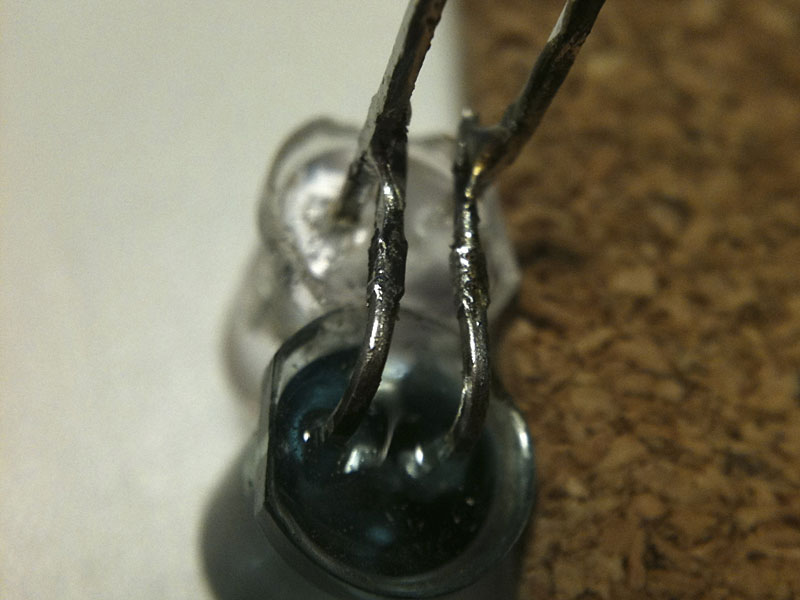
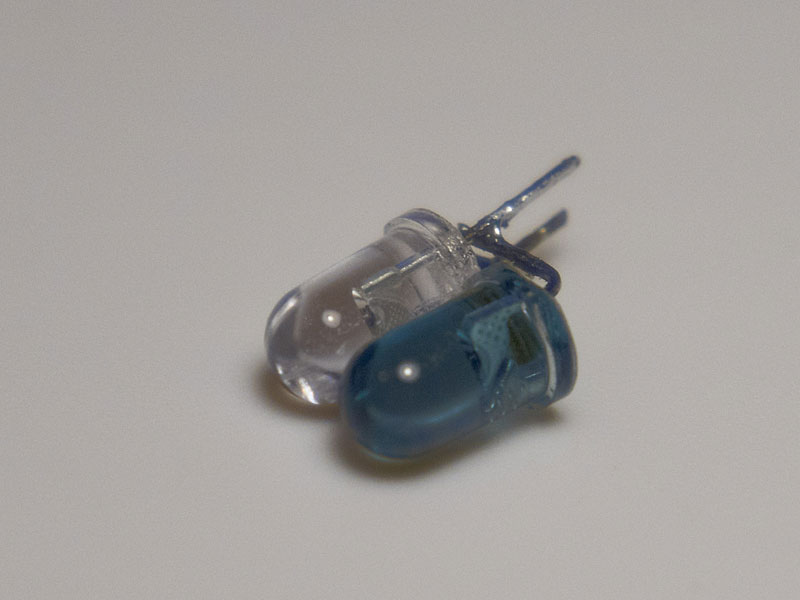
Sticking metal legs need to bite.
Now we take, as I have already written, the cheapest, nonseparable stereo plug and with a knife we cut off all pressed rubber, exposing its core. All wiring unsolder:
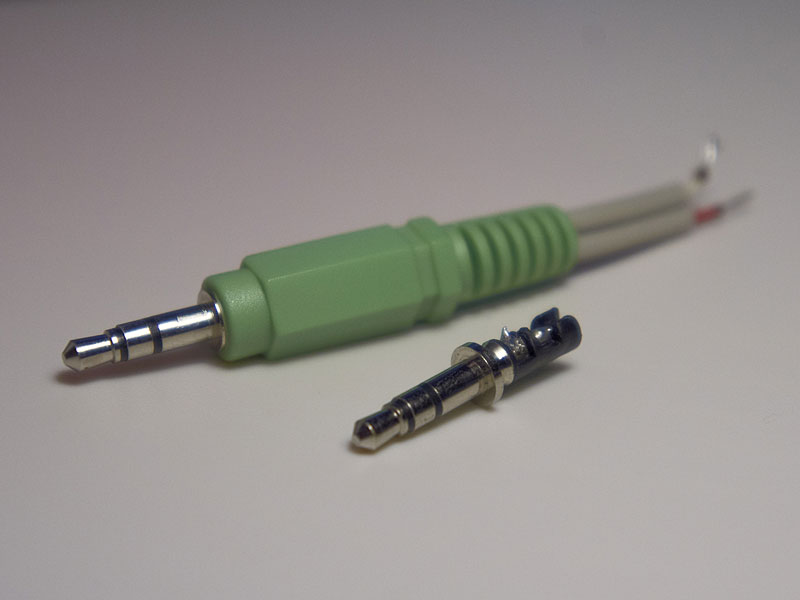
Excess plastic in the end can also be bitten off.
Now we solder two parallel metal legs with LED brackets to the two plugs of the plug:

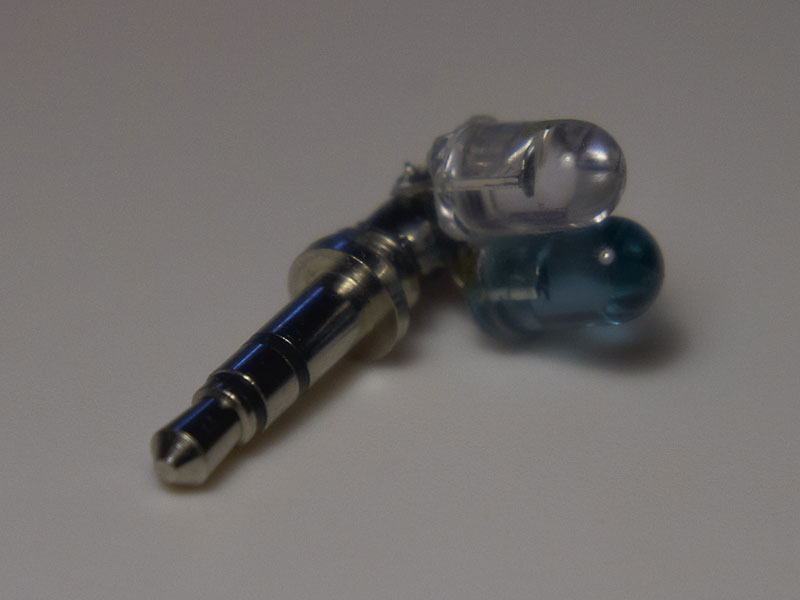
By and large, it is already possible to use it (at least, to conduct the first experiments).
We take the beloved grandmother's MP3 player, gathering dust on the mezzanine. In my case, it was already a 512-megabyte device, the possibilities of which are enough for the eyes.
Fill it with an MP3 file containing a special sequence of pulses that our diodes will reproduce as a valid IR package (in our case this is a shutter release signal for SONY digital cameras).
We connect the unit to the player and play the file (do not forget to turn on the control mode on the camera using the IR remote control). The player is better placed at a distance of 10-40 cm from the IR receiver of the camera). The player’s volume should be set to maximum (this is important!)
After everything has worked, you can proceed to the aesthetic component. I covered the LEDs and the plug with polycaprolactone to make a strong and rigid structure that can be safely thrown to the bottom of a backpack or into a pocket, and nothing will happen to it.
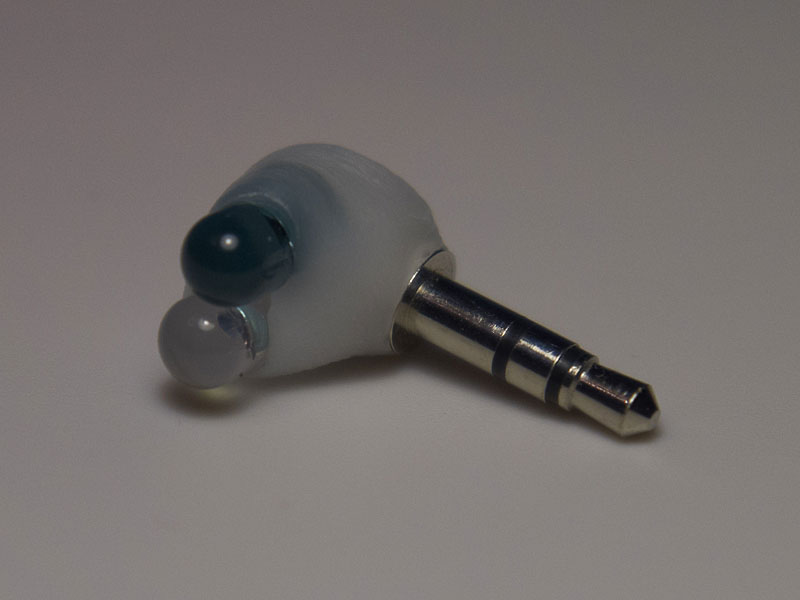

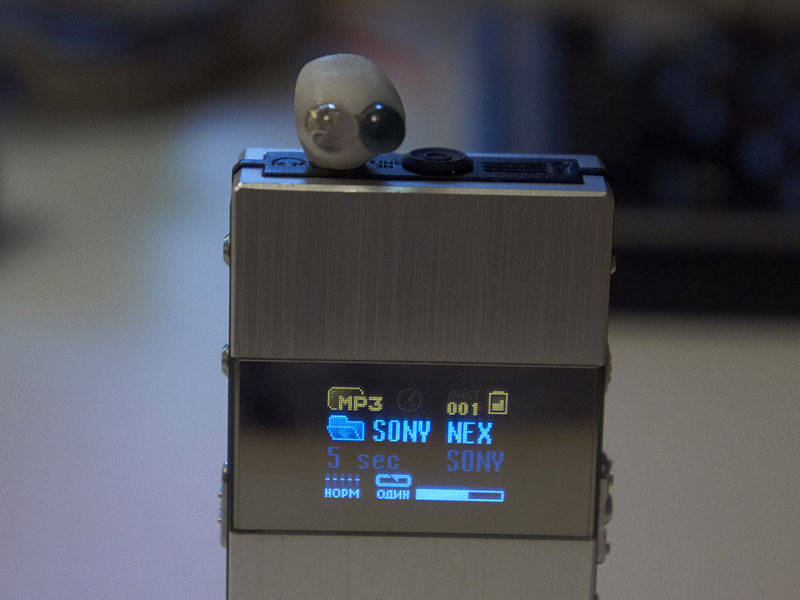
Instead of polycaprolactone (which is, in fact, the second most useful product after scotch and you simply have to be in the house of every self-respecting person), you can try pouring hot melt on the scheme or stick it with self-hardening clay.
Not a SONY single person alive. Surely you come to try it on some other device. Good people did everything for us. As part of the open-source package ledrem, there is a utility that converts files-descriptions of IR commands in the LIRC format (and the latter are easy to get).
And here the situation is very simple - all this is free of charge in any MP3 player. We create an audio track, at the beginning of which there is an IR package, and then for N seconds or minutes there is silence (it is most convenient to do this in Audacity ). We put such a track in the MP3-player and select the looped mode of playing one track. Now, until we stop playback (or until the batteries are exhausted), the camera's shutter will fire at the correct interval. You can immediately create a set of files ("5 seconds", "10 seconds", "30 seconds", "1 minute", "5 minutes", ...), pour them all into the player and choose the ones you need depending on the nature of the shooting.
And for uncompromising photographers even find applications for the iPhone and Android .
What is described in this lesson is not a discovery, and it is described in quite a few places , and even patented .
First, a video of the final result:
')
And now the details:
In general, I wanted to fuck an intervalometer for my camera to experiment with time-lapse photography. Finished products on the net are rare, and even those cost more than $ 50 + shipping. Therefore, I decided to go my own way in order to enjoy not only the final function, but also the process. The first experiment was on the Arduino - in the forehead a circuit with a relay that closed the button of the standard console. Of course, it worked, but you will not use this thing “in the field”.
I decided to simplify the scheme and look for the IR sequences for the command I need. And in the process, as always, it turned out that there is a simple as two kopeck scheme that can be implemented literally from scrap materials.
As a result, it seems to me, the scheme turned out not only simple and fast to manufacture, but also very miniature.
What we need
Minimum:
- two IR LEDs (they can be dropped from any unnecessary / broken control panels)
- one 3.5mm stereo jack from the cheapest wire (I took the one that came with the monitor in the appendage).
Optional:
- An old MP3 player that can be used as a “dedicated” intervalometer device. But the phone will do.
- any material for the body.
Scheme
The scheme is as follows: two LEDs are soldered to each other ("+" one to "-" the other), and then the left and right channels of the audio jack are soldered to these two wires; The “ground” from the plug is not used at all. This is most clearly depicted by one Chinese comrade:

Process
Since we want to achieve a miniature product, then first we sand down the contacting sides of both LEDs on emery paper, and then we combine them with a drop of superglue. After that, in one of the LEDs we fold the terminals horizontally and solder them to the terminals of the first:


Sticking metal legs need to bite.
Now we take, as I have already written, the cheapest, nonseparable stereo plug and with a knife we cut off all pressed rubber, exposing its core. All wiring unsolder:

Excess plastic in the end can also be bitten off.
Now we solder two parallel metal legs with LED brackets to the two plugs of the plug:


By and large, it is already possible to use it (at least, to conduct the first experiments).
Testing
We take the beloved grandmother's MP3 player, gathering dust on the mezzanine. In my case, it was already a 512-megabyte device, the possibilities of which are enough for the eyes.
Fill it with an MP3 file containing a special sequence of pulses that our diodes will reproduce as a valid IR package (in our case this is a shutter release signal for SONY digital cameras).
We connect the unit to the player and play the file (do not forget to turn on the control mode on the camera using the IR remote control). The player is better placed at a distance of 10-40 cm from the IR receiver of the camera). The player’s volume should be set to maximum (this is important!)
1 ... 2 ... Click!
After everything has worked, you can proceed to the aesthetic component. I covered the LEDs and the plug with polycaprolactone to make a strong and rigid structure that can be safely thrown to the bottom of a backpack or into a pocket, and nothing will happen to it.



Instead of polycaprolactone (which is, in fact, the second most useful product after scotch and you simply have to be in the house of every self-respecting person), you can try pouring hot melt on the scheme or stick it with self-hardening clay.
How to create such audio files?
Not a SONY single person alive. Surely you come to try it on some other device. Good people did everything for us. As part of the open-source package ledrem, there is a utility that converts files-descriptions of IR commands in the LIRC format (and the latter are easy to get).
So what about the intervalometer?
And here the situation is very simple - all this is free of charge in any MP3 player. We create an audio track, at the beginning of which there is an IR package, and then for N seconds or minutes there is silence (it is most convenient to do this in Audacity ). We put such a track in the MP3-player and select the looped mode of playing one track. Now, until we stop playback (or until the batteries are exhausted), the camera's shutter will fire at the correct interval. You can immediately create a set of files ("5 seconds", "10 seconds", "30 seconds", "1 minute", "5 minutes", ...), pour them all into the player and choose the ones you need depending on the nature of the shooting.
And for uncompromising photographers even find applications for the iPhone and Android .
Source: https://habr.com/ru/post/125506/
All Articles